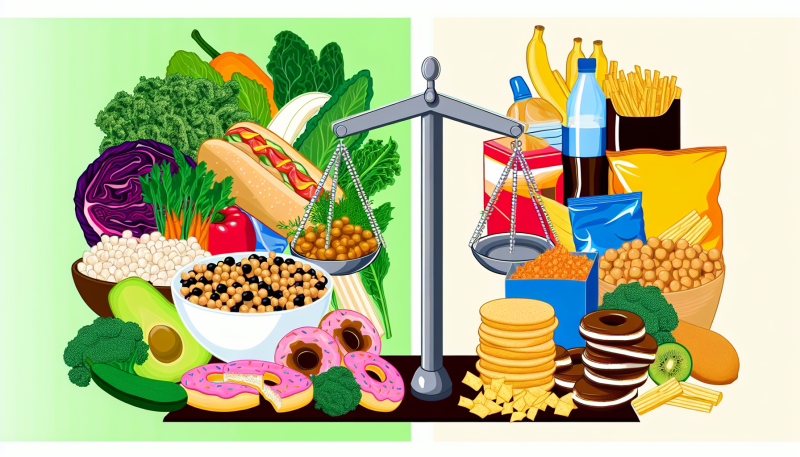A plant-based diet offers numerous benefits that can enhance your overall well-being. One of the most significant advantages is its positive impact on heart health. Foods rich in fruits, vegetables, whole grains, and legumes are low in saturated fats and cholesterol, helping to lower blood pressure and reduce the risk of heart disease. By choosing plant-based options, individuals may find themselves with better circulation and a healthier heart.
Another benefit of adopting a plant-based diet is weight management. Plant foods are typically lower in calories and higher in fiber, which promotes a feeling of fullness. This means you can eat satisfying portions without consuming excessive calories, making weight loss or maintenance more achievable. Many people who switch to a plant-based lifestyle report losing weight effortlessly while enjoying delicious and nutrient-dense meals.
Additionally, a plant-based diet can boost your energy levels. Whole plant foods provide a rich source of vitamins, minerals, and antioxidants that fuel the body and combat fatigue. Unlike processed foods that can lead to energy crashes, plant-based meals offer sustained energy throughout the day, allowing you to feel more vibrant and active.
Lastly, this type of diet is not only good for your health but also benefits the environment. By reducing your consumption of animal products, you contribute to lower greenhouse gas emissions, conserve water, and lessen deforestation. Choosing plant-based foods helps create a more sustainable future for our planet while promoting ethical treatment of animals.
Easy Plant-Based Food Swaps
Making the transition to a plant-based diet doesn't mean you have to miss out on your favorite foods. In fact, there are plenty of easy swaps you can make that allow you to enjoy delicious meals while embracing a healthier lifestyle. Here are some simple substitutions to help you get started on your journey.
One of the most common changes is swapping dairy milk for plant-based alternatives. Almond milk, oat milk, and soy milk are all great choices that can be used in your morning coffee or on your cereal. Not only do these alternatives have fewer calories, but they also provide a variety of nutrients. If you're a fan of cheese, try using nutritional yeast to sprinkle on pasta dishes or salads for a cheesy flavor without the dairy.
Another easy swap is replacing ground meat with lentils, chickpeas, or plant-based meat substitutes. For example, you can create a hearty chili using lentils or make delicious veggie burgers from black beans. These alternatives are packed with protein and fiber, making them satisfying options for any meal. If you're craving creaminess in your dishes, consider using avocado or hummus instead of mayonnaise or sour cream. They provide healthy fats and a rich taste that can enhance sandwiches and dips.
When it comes to pasta, you can opt for whole grain or legume-based noodles, which offer more nutrients than traditional white pasta. Vegetable noodles, like zucchini or spaghetti squash, are also a fun alternative that adds extra servings of veggies to your plate. Pair them with a homemade tomato sauce or a drizzle of olive oil for a light and tasty meal!
Lastly, think about your snacks! Instead of reaching for chips, try air-popped popcorn seasoned with your favorite spices, or enjoy crunchy veggie sticks with hummus. These swaps are not only satisfying but also keep your body fueled with wholesome ingredients. Experiment with these options and discover how easy it can be to enjoy a plant-based diet!
Tips for Transitioning to Plants
Transitioning to a plant-based diet can be a rewarding experience, but it can also feel daunting at first. To make the shift smoother, start by incorporating more plant-based meals into your routine gradually. Instead of overhauling your diet overnight, try adding a meatless day each week. This way, you can explore different recipes and flavors without feeling overwhelmed.
As you transition, it's important to keep your meals interesting. Explore new plant-based ingredients like quinoa, lentils, and chickpeas. You can also experiment with herbs and spices to enhance the flavors of your dishes. Create a list of your favorite fruits and vegetables, and use them as the foundation for your meals. This not only adds variety but helps you discover what you love.
An essential part of transitioning is learning to cook. If you're new to cooking, start with simple recipes that require minimal ingredients. There are countless resources available, from cookbooks to online videos, that can guide you through the process. Don't be afraid to get creative in the kitchen and modify recipes to suit your taste!
Lastly, it's crucial to listen to your body. As you adopt more plant-based foods, you might experience changes in your energy levels and digestion. Pay attention to how different foods make you feel, and adjust your diet accordingly. Remember, this journey is about finding balance and nourishing your body in a way that feels good for you.
Delicious Recipes for Every Meal
Eating healthy doesn’t have to be boring! Here are some delicious plant-based recipes that are perfect for any meal of the day. Whether you are a breakfast lover, lunch enthusiast, or dinner devotee, these recipes are sure to tantalize your taste buds and keep your body happy.
Breakfast: Banana Oatmeal Pancakes
Start your day with a stack of fluffy banana oatmeal pancakes. Simply blend 1 ripe banana, 1 cup of oats, and 1 cup of almond milk until smooth. Pour the batter onto a hot skillet and cook until golden brown. Serve with fresh berries and a drizzle of maple syrup for a sweet morning boost!
Lunch: Quinoa Salad with Spinach and Chickpeas
For a refreshing lunch, try a quinoa salad packed with nutrients. Cook 1 cup of quinoa and let it cool. In a large bowl, toss the quinoa with 2 cups of fresh spinach, 1 can of rinsed chickpeas, cherry tomatoes, and diced cucumbers. Dress it with olive oil, lemon juice, salt, and pepper for a vibrant, filling meal.
Dinner: Spaghetti with Avocado Sauce
Make dinner a breeze with spaghetti topped with creamy avocado sauce. Cook your favorite whole grain spaghetti. In a blender, combine 2 ripe avocados, 2 cloves of garlic, a squeeze of lemon juice, and a handful of fresh basil leaves. Blend until smooth, and mix it with the drained spaghetti. Top with cherry tomatoes and a sprinkle of nutritional yeast for a satisfying meal.



